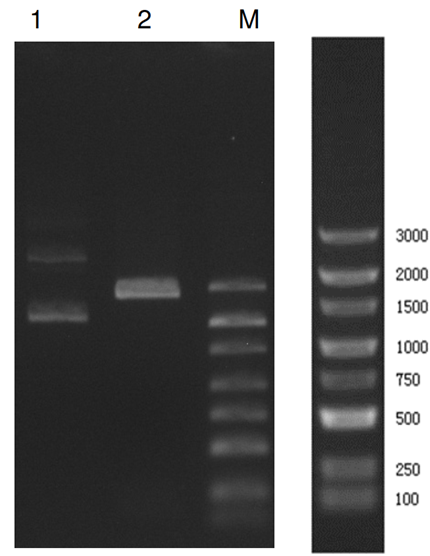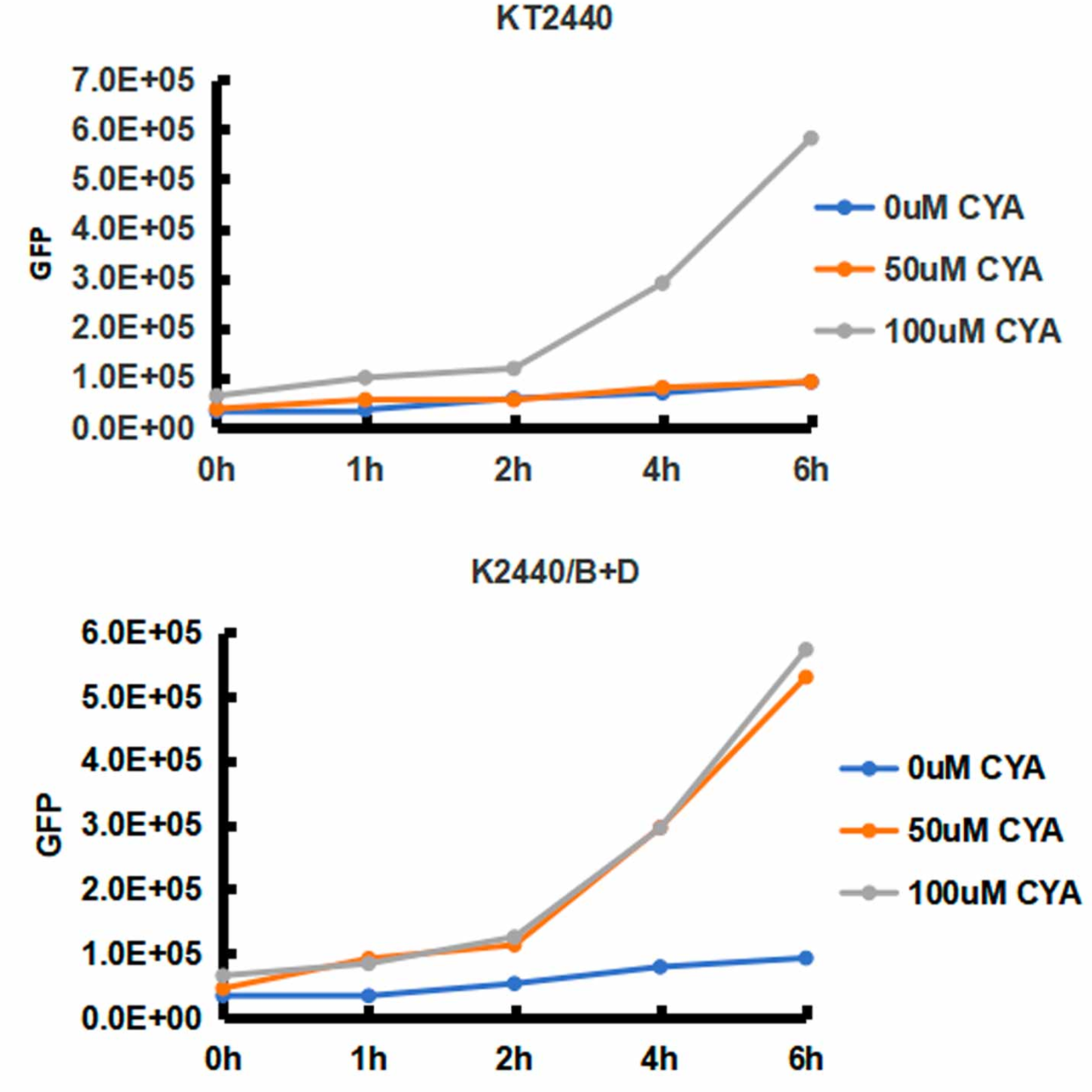Part:BBa_K3995007
Ptat_AtzR+Pprovoin5_amilGFP
Ptat_AtzR+Pprovoin5_amilGFP
Profile
Name: Ptat_AtzR+Pprovoin5_amilGFP
Base Pairs: 2254 bp
Origin: Synthetic
Properties: A coding sequence for detecting cyanuric acid.
Usage and Biology
Ptat_AtzR+Pprovoin5_amilGFP is a coding sequence for detecting cyanuric acid. Atrazine is one of the most widely used herbicides in the world. It is cheap and also effective on many crops. But it still has negative effects. Atrazine will leave a residue in the soil called cyanuric acid, it has endocrine disruption, genotoxicity, reproductive toxicity and other harm to mammals. Ptat_AtzR+Pprovoin5_amilGFP functions as a cell-free gene element to detect cyanuric acid. Cyanuric acid combination with AtzR can activate amilGFP expression to show the signs of fluorescence. The content of cyanuric acid is detected by detecting the fluorescence concentration.
Construct design
amilGFP is key functional factors that show the signs of fluorescence which is controlled by a Pprovoin5 promoter (Figure 2). The atzR is under Ttat promoter. The Pprovoin5_amilGFP and the Ptat_atzR are inserted in the pUC57 mini vector respectively to get plasmid A and plasmid B (Figure 3).
The profiles of every basic part are as follows:
BBa_K3995009
Name: Ptat
Base Pairs: 155bp
Origin: Pseudomonas aeruginosa, genome
Properties: A constitutive promoter for initiation of the transcription.
Usage and Biology
Tat promoter is a promoter from Pseudomonas aeruginosa PAO1. Shah and Naseby constructed plasmids carrying lux genes which are under the control of constitutive promoters and tested the strength of five different constitutive promoters (Plpp, Ptat, PlysS, PldcC, Pspc) with the method of bioluminescence-based measurement. They found that Promoter strength decreased in the order of Plpp > Ptat > PlysS > PldcC > Pspc during exponential phase whilst Ptat was stronger than Plpp during stationary phase. Stationary phase was observed from 12 h for all the strains and remained constant up to 48 h
BBa_K3995001
Name: AtzR
Base Pairs: 969bp
Origin: Pseudomonas sp.
Properties: A protein binding cyanuric acid
Usage and Biology
BBa_K3995001 is a coding sequence of atzR. Cyanuric acid combining with atzR can activates Pprovoin5 promoter. So atzR can act as a sensor.
BBa_K3995002
Name: Pprovoin5
Base Pairs: 82bp
Origin: Pseudomonas sp.,genome
Properties: atzDEF/atzR operator
Usage and Biology
This operator region has a leftward-facing repressible promoter and a rightward-facing activated promoter. AtzR remains bound to the DNA. In the natural system, the left-facing promoter is upstream of the atzR CDS, and atzR is autoregulatory; in the presence of cyanuric acid, the binding of AtzR changes to cause the right-facing promoter to become activated, allowing for the expression of the downstream atzDEF CDS. The presence of cyanuric acid "frees" AtzR from being bound to the atzDEF promoter so polymerase can now bind and transcribe following gene. AtzR remains bound to the atzR promoter region even in the presence of cyanuric acid.
BBa_K4030002
Name: TT
Base Pairs: 140bp
Origin: Escherichia coli
Properties: Transcription terminator
Usage and Biology
It is an transcription terminator derived from the E.coli rrB rRNA operon
BBa_K592010
Name: amilGFP
Base Pairs: 699bp
Origin: Acropora millepora
Properties: A yellow chromoprotein
Usage and Biology
This part is useful as a reporter and it naturally exhibits strong yellow color when expressed.
Experimental approach
Construction of recombinant plasmid
pUC57_mini plasmid and gene atzR were enzyme digestion. And then pUC57_mini backbone and atzR-fragment were connected by T4 ligase. Finally, we did double enzyme digestion and sequencing for recombinant plasmid pUC57_mini_atzR. We got correct plasmid.
Left: Lane pUC57-amilGFP: Plasmid pUC57-mini-vector-amilGFP digested by Bsa1 and the band at around 750bp (amilGFP: 703bp) was got. Lane pUC57-Pprovoin5: Plasmid pUC57-kana-mini-Pprovoin5 (2097bp) digested by Bsa1. Right: Lane pUC57-amilGFP: amilGFP (703bp) was got by PCR method. This step is used to get the plasmids pUC57-Pprovoin5 digested by enzyme and gene amilGFP by PCR method for later in the process. Therefore, channel pUC57-Pprovoin5 plasmids were done enzyme digestion of BsaI. And channel pUC57-amilGFP were gene amilGFP got by PCR. Clean-up the product of pUC57-Pprovoin5 and pUC57-amilGFP to obtain pUC57-Pprovoin5 backbone and amilGFP-fragment. T4 DNA ligase is used to connect pUC57-Pprovoin5 backbone with amilGFP-fragment.
Lane pUC57 -Pprovoin5-GFP-1 to 3: Bacteria PCR of monoclonals of amilGFP with size of 703bp. 1 to 3 were positive monoclonals. Extract 1 to 3 plasmids for sequencing.
Proof of function
As seen from figure 8, comparing to the blank control, bacteria C presents an obvious higher fluorescence reaction to the cyanuric acid, the derivative from Atrazine. In such a case, it could indicate that our engineered bacteria could work for detecting cyanuric acid.
In order to analyze the relationship between the concentration of cyanuric acid and the fluorescence intensity, we designed the control groups and collected the data as showing above. According to the histograms (Fig. 9 and Fig. 10), the fluorescence intensity shows a decreasing trend with the increase of concentration of cyanuric acid when we used the bacteria C for tests. Therefore, we speculate that the cyanuric acid might affect the growth of strains so that the higher the concentration of the cyanuric acid, the worse the growth of the bacteria, the less of the amount of the effective “biosensor”. In order to fully eliminate this impact, we introduced the concept of cell-free extraction and cell-free expression in the next stage of our project.
In order to analyze the relationship between the fluorescence intensity and the induction hours, we collected the data and drew the curves under various concentrations of cyanuric acid (CYA) as showing above. In figure 11, we can see that basically there is an increasing trend of the fluorescence intensity of bacteria C as the induction hour increases. In addition, the curves also indicate that the appropriate detection hour for our biosensor to detect cyanuric acid would be 4 hours later where several curves tend to balance.
Improvement of an existing part
According to the registry, the part BBa_M33330 designed by group Stanford BIOE44 - S010, described a regulated circuit about atzR. However, there was no any experiment results or wiki documentation in support of its function. The group iGEM20_Shanghai_city designed a composite part BBa_K3526006 according to BBa_M33330. They optimized the coding sequence of atzR and added corresponding parts, such as a constitutive-promoter tac, a regulated-promoter PatzD, a reporter EGFP, and a terminator T7. Their composite part BBa_K3526006 was given a completely new function, detection of the presence of cyanuric acid by observed green fluorescence.
Compared to the old part BBa_K3526006, we designed a new composite part BBa_K3995007, with sequence different from the old one BBa_K3526006 (Figure 12). We are going to design portable instrument to detect the content of residue in herbicide. In this biosensor system, protein atzR is first expressed, which has been previously reported as a CYA binding protein and can regulate the promoter Pprovoin5. So as to activate the expression of downstream reporter gene amilGFP. The fluorescence signal of amilGFP can be detected by the fluorescence detector and the concentration of CYA can be determined by signal intensity. And this is a cell-free gene system reaction. So compared with the group iGEM20_Shanghai_city, our system doesn’t have to worry about microbial contamination.
Besides, compared to the group iGEM20_Shanghai_city, our results show that bacteria C presents an obvious higher fluorescence reaction to the cyanuric acid than that of blank control. However, as shown in Figure 13, the results of group iGEM20_Shanghai_city show that their blank control presents a same fluorescence reaction to the cyanuric acid with that of experiment group.
In addition, we will establish a business development department aiming at connecting with the administration departments of farms, through which we hope that our products could be distributed efficiently since the administrations usually have huge power to impact our end users, farm operators. The environment monitoring industry is also interested in purchasing atrazine detection devices, we will also identify it as our future clients. We hope to connect with the related industry associations to get our products distributed efficiently.
Future plan
1. In order to further figure out the influence of cyanuric acid on the growth of bacteria C, there shall be several control experiments to be conducted, such as to determine the growth curves of bacterial strains under different concentrations of cyanuric acid.
2. As we just attempted the cell-free extraction once, this technique requires more experimental conditions groping to solid this part of work and collect more products for future cell-free expression use.
3. Once we obtain enough products of cell-free extraction, we could step into the cell-free expression experiments to ensure the performance of our biosensor without bacteria.
4. In order to achieve our final goal, the 3D print would be necessary for us to build the device which could load our cell-free biosensor and conduct more function tests with it. In the meantime, as the buffer in cell-free expression needs to be freshly configured, it is necessary to explore ways to preserve the product if it is made into a portable detection device.
5. In the future, we hope to carry our device to detect the content of cyanuric acid in lake/river water and other environmental water.
References
1.Zhang X, Huang Q, Zhao ZZ, Xu X, Li S, Yin H, Li L, Zhang J, Wang R. An Eco- and User-Friendly Herbicide. J Agric Food Chem. 2019 Jul 17;67(28):7783-7792. doi: 10.1021/acs.jafc.9b00764. Epub 2019 Jul 3. PMID: 31267752.
2.Zhu M, Wang L, Wang Y, Zhou J, Ding J, Li W, Xin Y, Fan S, Wang Z, Wang Y. Biointeractions of Herbicide Atrazine with Human Serum Albumin: UV-Vis, Fluorescence and Circular Dichroism Approaches. Int J Environ Res Public Health. 2018 Jan 11;15(1):116. doi: 10.3390/ijerph15010116. PMID: 29324720; PMCID: PMC5800215.
3.Silverman, Adam D., et al. "Deconstructing cell-free extract preparation for in vitro activation of transcriptional genetic circuitry." ACS synthetic biology 8.2 (2018): 403-414.
4.1.Liu, Xiangyang, et al. "Design of a transcriptional biosensor for the portable, on-demand detection of cyanuric acid." ACS synthetic biology 9.1 (2019): 84-94.
Sequence and Features
- 10INCOMPATIBLE WITH RFC[10]Illegal EcoRI site found at 548
Illegal EcoRI site found at 1091 - 12INCOMPATIBLE WITH RFC[12]Illegal EcoRI site found at 548
Illegal EcoRI site found at 1091
Illegal NheI site found at 124 - 21INCOMPATIBLE WITH RFC[21]Illegal EcoRI site found at 548
Illegal EcoRI site found at 1091
Illegal XhoI site found at 1370 - 23INCOMPATIBLE WITH RFC[23]Illegal EcoRI site found at 548
Illegal EcoRI site found at 1091 - 25INCOMPATIBLE WITH RFC[25]Illegal EcoRI site found at 548
Illegal EcoRI site found at 1091
Illegal AgeI site found at 938 - 1000COMPATIBLE WITH RFC[1000]
| None |















